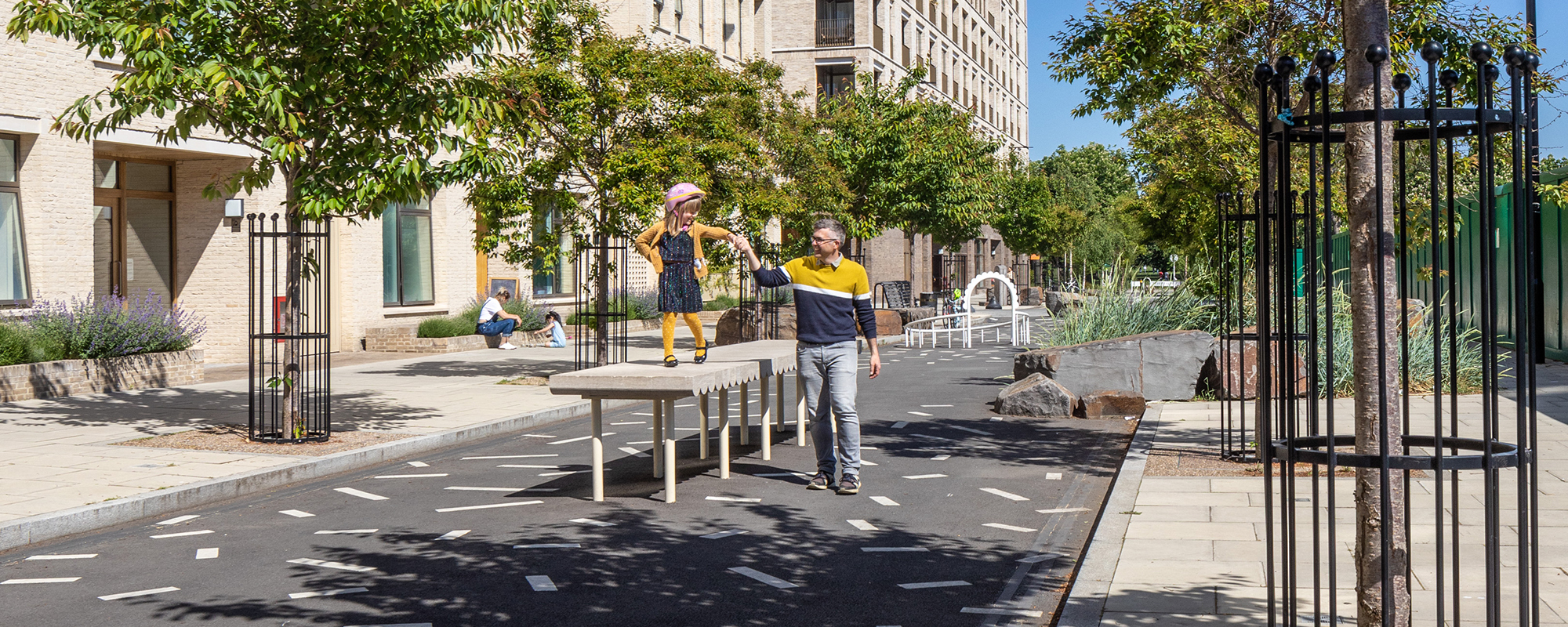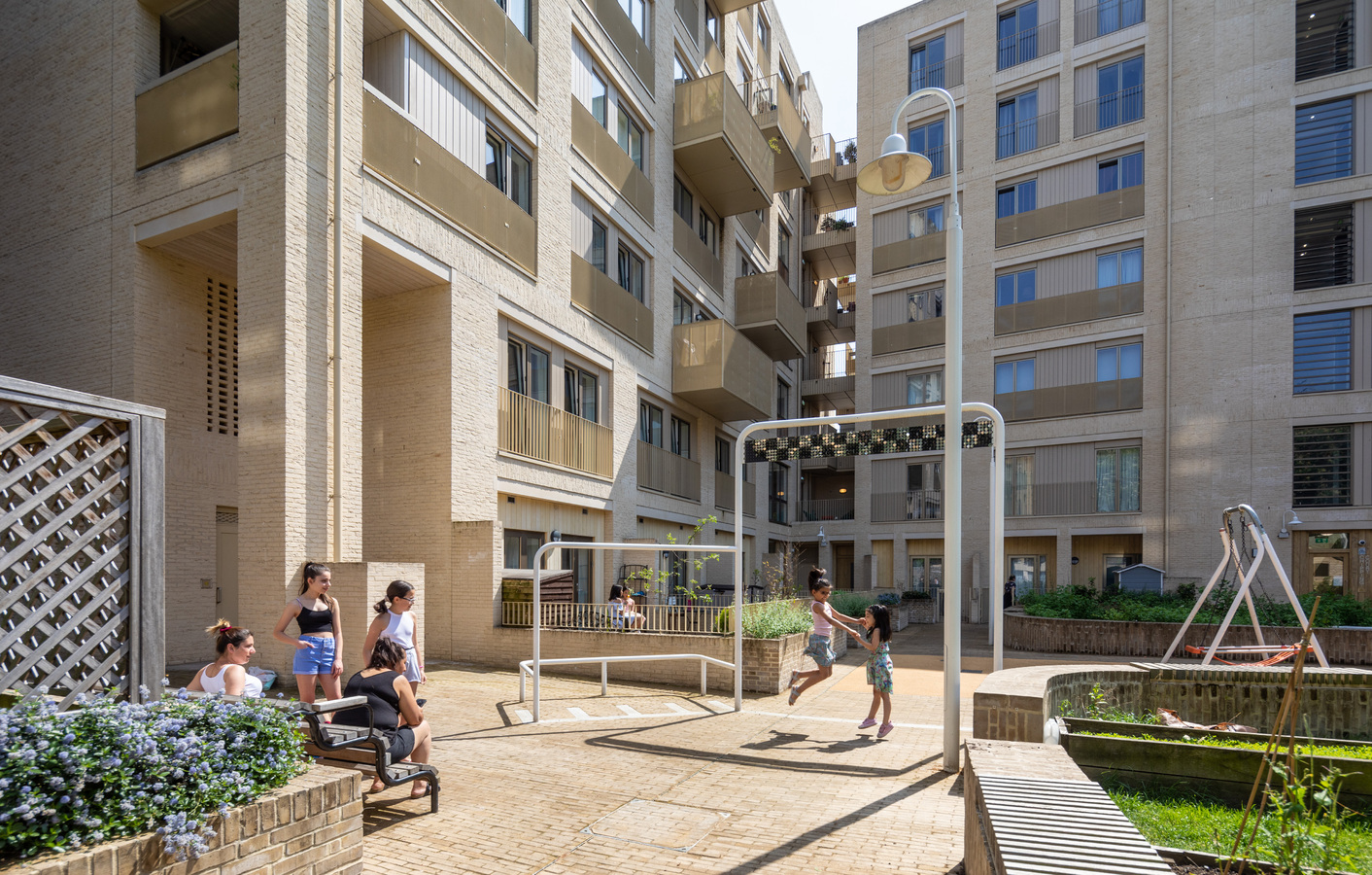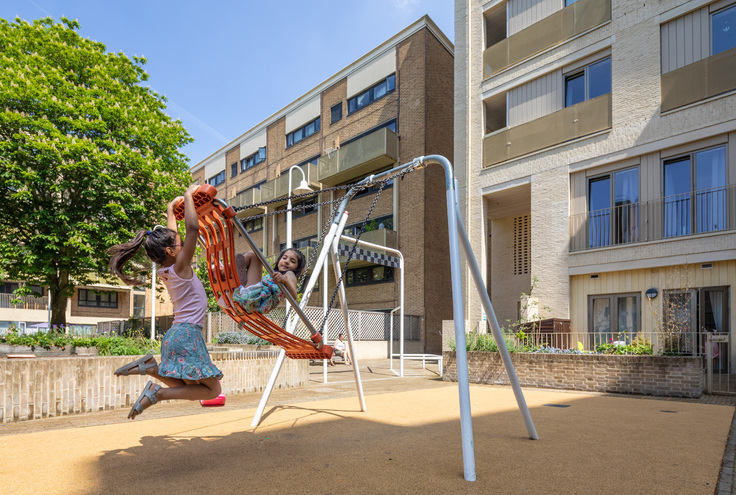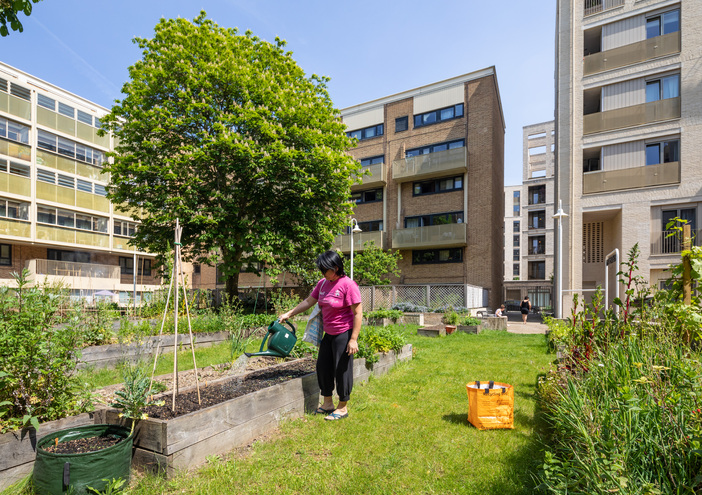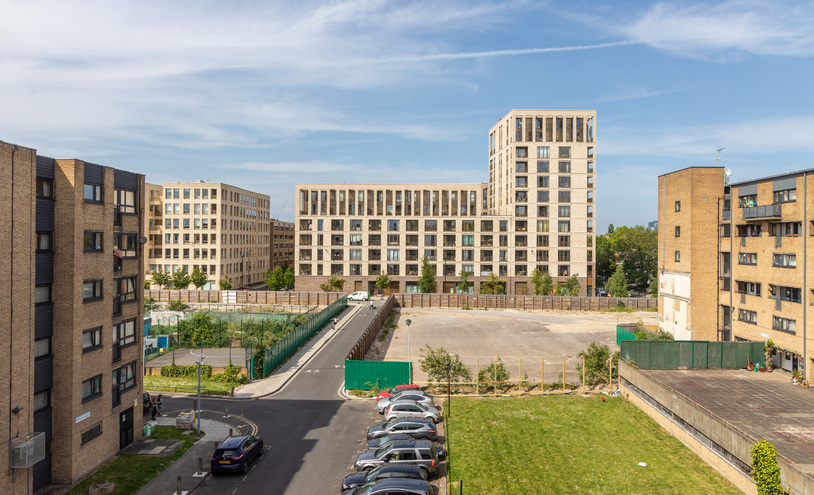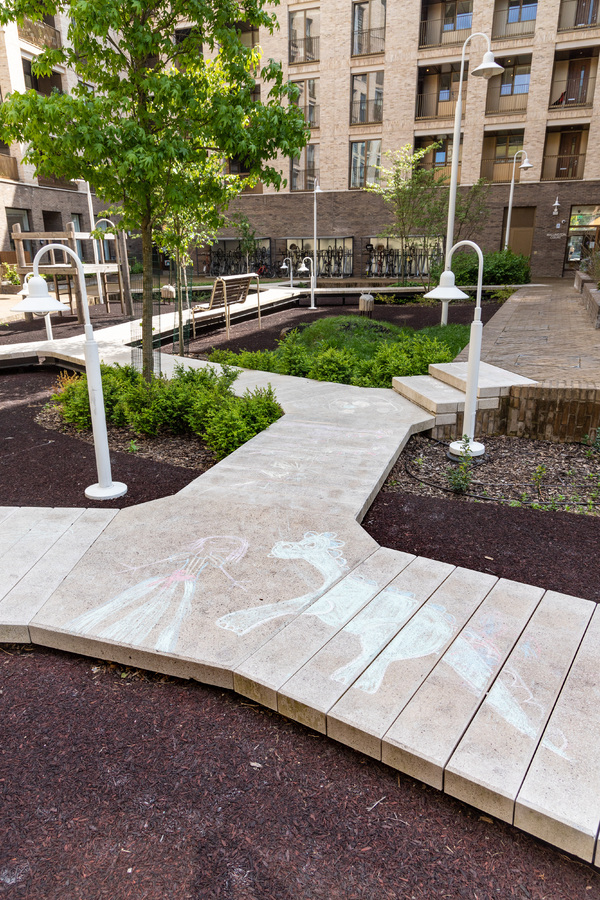Get updates from The Developer straight to your inbox Yes, please!
Placetest: King's Crescent Estate
Placetest King’s Crescent Estate: A part-demolished estate in Stoke Newington is enjoying an ambitious regeneration full of flux and possibility. Anna Wood and Nitasha Kapoor meet the residents enjoying its revival. Photography by John Sturrock
Kings Crescent Estate has survived more than four decades of mixed fortunes. It had its streets-in-the-sky beginnings in the ’70s, then suffered partial demolition in the ’90s. The 2000s brought stalled regeneration projects from various developers, and now there is ongoing redevelopment by Hackney Council, designed by Karakusevic Carson Architects with Henley Halebrown Rorrison and Muf Architecture/Art.
Work began on site in spring 2015 and the first two phases of 269 new homes and 101 refurbished homes were completed in 2017. The next phases are due to start in 2021, to provide a further 28 council, 75 shared ownership and 116 private homes, as well as ‘upgrades’ to 174 existing properties.
“There’s a feeling of things happening, of life coming back to Kings Crescent again,” says resident Jill Walker-Murrain. “And it makes me smile. I love it. We’d been fighting for the regeneration for so many years and a lot of us were quite worn out.”
Walker-Murrain has lived on the estate for 38 years. She moved in when she was 22, before being ‘decanted’ from Sandridge Court to another block before it was demolished, and has raised her three daughters here. She has been secretary of the tenants’ association, set up youth clubs, been a youth mentor, co-founded a gardening group and had been active on steering committees; she now works as site administrator for Higgins, the construction company for the current redevelopment.
Her husband, Vince Murrain, was equally vital to the estate. The chair of the tenants’ association, he died in 2012 but remains a much-loved man – the new community centre and the main street running through Kings Crescent are named after him.
“It started off with just kids from the estate,” Walker-Murrain says of the youth club, delighting in how small initiatives grow. “And then it was, ‘Can my friends come?’ Then social services heard about us, so we’d be getting referrals of kids-at-risk, and then I became a mentor. We’d have up to 150 kids a day, which was amazing, so we employed other people, tutors and different coaches, all through word-of-mouth.”
We had to have space for people to grow food. It’s good for the environment, it’s good for your mental health, it’s good for bringing community together
Children are still at the heart of the estate – even more so, now that a new “play street” designed by Muf Architecture/Art runs down the centre of the development. The play street, a (mostly) pedestrianised road, is at once a playground and the main thoroughfare for Kings Crescent. Ground-floor spaces along it are used for kids’ play mornings, and the new cafe round the corner is a meeting and relaxing spot for toddlers and their carers.
The next phase of development includes more swings, benches and climbing structures between the play street – Murrain Road – and the Vince Murrain Community Centre. A Sainsbury’s on the edge of the estate helps blur the line between Kings Crescent and the wider world.
Emley Pine is a young mother taking an ever-expanding role on the estate. She and her partner live with their two children in one of the flats being refurbished as part of the development; she is in the tenants’ and residents’ association, which has been working with local arts charity Hackney Showroom to fund, refurbish and run another community space along Murrain Road.
“You can feel stuck in a hamster wheel of meetings,” she says. “Sometimes you get things off your chest but that’s it – you don’t get anywhere. So, we’ve been bringing the right people from different groups to meet face-to-face.”
Residents who have been here for decades are living alongside newcomers who have moved into flats they bought off-plan; those new builds are different to, but sympathetic with, the older blocks, which have been refurbished as part of the regeneration. Residents share locked and fobbed courtyards, but another big play area with more traditional equipment is planned that will be open to all residents and anyone else who wants to come and share the space.
“All new buildings benefit from a variety of tenures and are designed as fully tenure blind,” architect Paul Karakusevic says. “Tenures are split by cores. The entrances are all ‘through-lobbies’ with access directly to the courtyards. Ultimately the decision on detailed security lines and fobbed access is decided by the client team, in conversation with the residents and design team.”
There is plenty of unfinished work here – more buildings will go up in the next three years, but currently, there are empty lots fenced in by builders’ boards.
“You can feel stuck in a hamster wheel of meetings. Sometimes you get things off your chest but that’s it – you don’t get anywhere. So, we’ve been bringing the right people from different groups to meet face-to-face”
It is all in-progress, not fixed – Kings Crescent, to paraphrase Robert Venturi, chooses “messy vitality over obvious unity”.
There are problems, too. There is not nearly enough social housing here to meet local need yet there are also objections to the 12-storey blocks that will soon go up and inevitably block light and views for existing flats. And there are other, smaller but not insignificant issues. There is a loss of social spontaneity that affects some more than others – you need advanced permission to have a party outdoors, for example, and barbecues aren’t allowed anywhere.
One young resident in an older block says the one thing she would change is “the smell in the hallway” (residents in the new blocks are not greeted by the whiff of urine). Some of the paving stones are slippery with mossy growth all winter; they are apparently immune to scrubbing and almost begging to break someone’s hip.
But Hackney Council has succeeded where at least three other housing associations failed – it has found a way to regenerate Kings Crescent that is financially viable and socially valuable.
“It feels like the same estate as it was 40 years ago,” says Walker-Murrain. “It’s the same and it’s changed. You want continuity and you want fresh blood coming in: you need both.”
Like Venturi, she is enthused by complexity and contradiction, richness and ambiguity. Venturi wrote: “Architecture must embody the difficult unity of inclusion rather than the easy unity of exclusion.” Walker-Murrain puts it more succinctly: “Everybody has to be OK or there’s no point.”
Liza Fior, founder of Muf Architecture/Art, is in chorus with Walker-Murrain, particularly when it comes to providing for young people with the utmost ambition and generosity. Fior argues that the play street was perhaps the keystone to her company’s proposal, because “you prioritise either cars or children”.
Fior shares a lot of Walker-Murrain’s great energy, priorities and insights. Through projects with local authorities across London, including Dalston Eastern Curve Garden, Ruskin Square and the Max Roach Play Park, Fior has a bone-deep sense of how to get on with things, relish untold possibilities, and nurture ever-changing networks of people and ideas – collaborating with the future.
Muf co-founder Kath Shonfield also coined the term ‘premature gratification’. Evident at Kings Crescent in the play street, premature gratification helps guarantee the completion of a project by making it satisfying and fully itself straight away. Rather than expecting people to trust you when you say that this new place will be worth waiting for, you make sure, right from the start, that each aspect gives you a sense of why the whole thing deserves your time. Or as Shonfield puts it: “It makes you want to eat more because the hors d’oeuvres tasted so good.”
The play street caters to diverse and multiple needs. The main route into and through the estate, it is also a place for play and relaxation, and leads to Clissold Park. Theatre, nature and function are all playfully mixed together.
Rather than expecting people to trust you when you say that this new place will be worth waiting for, you make sure, right from the start, that each aspect gives you a sense of why the whole thing deserves your time.
Fior says it is partly inspired by Venice – a city that doesn’t need playgrounds because children can play anywhere they like. The design is wilfully unclear and non-prescriptive, with objects open to interpretation, but also perfectly accurate, sized and laid out for children so that it “makes invitations”, as Fior puts it, without telling you what to do.
Groups of young men meet up and hang out there. Two siblings we spoke to run races along the long concrete table fixed in the middle of the street. “Is it a sacrificial plinth?” a resident asks, arching an eyebrow; another young woman had a birthday party around the table.
There are benches as well; Fior points out that benches are easy and important, adding: “If children and older people are OK then everyone’s OK.” There are whispering posts, and a carefully arranged and secured pile of logs provides home to untold insects. There’s a hammock that Walker-Murrain’s severely autistic young granddaughter loves to lie in.
“It’s safe because there are no cars, so we go down there and she lies on the hammock,” says Walker-Murrain.
“She just swings away and she’s happy, and I sit there and watch her be happy.”
The design of the estate mirrors the behaviour of those living there: you start specific and small but also open-ended and generous, and that enables things to grow. “Introducing play allows more play,” as Fior says, talking about how once they designed one play area, there came a demand for more play areas, which then became part of the next phase of regeneration.
Walker-Murrain saw the same thing happen with the estate’s gardens: the new allotments and the orchard along the east side of the estate emerged from a gardening club set up years ago, a meanwhile-use affair in another part of Kings Crescent the success of which demonstrated abundantly that there was demand for community gardens.
“The new allotments are there because we had that precedent and we said, in the tenants’ association that we have to have space for people to be able to grow food,” says Walker-Murrain. “It’s good for the environment, good for your mental health, and good for bringing community together.”
Kings Crescent was designed with shared informal spaces in mind, so that residents (and non-residents) feel that they are in a place that connects and responds not just to the surrounding streets and buildings but also to their own needs and wishes. After the hard, practical work (on all sides) of steering groups and permissions and funding and logistical puzzles, room has been left for the unknown.
There is a future unknown person who will walk safely up the pedestrianised Murrain Road, who will eat vegetables grown in the allotments and eat fruit from the orchard, who will whisper through the listening posts on the play street, and perhaps lie back on the long concrete table to soak up some sunshine. That person will have the sense, as with reading a book or listening to a piece of music, that someone else somewhere has thought well of them and has written, composed or designed something with specificity, honesty and a keen belief that they deserve the best of everything.
Anna Wood writes about music, sex and politics for publications including Mojo and The Quietus.
Nitasha Kapoor is an anthropologist and social researcher
Support The Developer on Patreon
Our journalism has always been free-to-air.
If you value what we publish, be our patron from £3 per month
If you love what we do, support us
Ask your organisation to become a member, buy tickets to our events or support us on Patreon
Sign up to our newsletter
Get updates from The Developer straight to your inbox
Thanks to our organisation members
© Festival of Place - Tweak Ltd., 124 City Road, London, EC1V 2NX. Tel: 020 3326 7238
